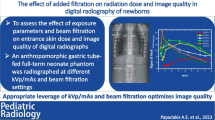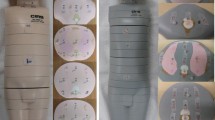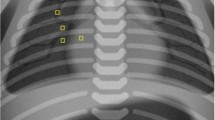Abstract
Background: To investigate optimizing the use of different beam shaping filters (viz. small, medium and large) when using different tube voltages during the newborn chest computed tomography (CT) on a GE Lightspeed VCT scanner. Methods: We used pediatric anthropomorphic phantoms with a 64 detector-row CT scanner while scanning the chest. A real-time skin dosimeter (RD − 1000; Trek Corporation, Kanagawa, Japan) was positioned into the phantom center of the body, the surface of the body back, and the right and left mammary glands. We performed and compared six scan protocols using small, medium, and large beam shaping filters at 80 and 120 kVp protocols. Result: There were no significant differences in the image noise for the chest scan among the different beam shaping filters. By using the large beam shaping filter at 80 kVp, it was possible to reduce the exposure dose by 5% in comparison with the small beam shaping filter, and by 10% in comparison with the medium beam shaping filter. By using the large beam shaping filter at 120 kVp, it was possible to reduce the exposure dose by 15% in comparison with the small beam shaping filter and by 20% in comparison with the medium beam shaping filter (p < 0.01). Conclusion: The large beam shaping filter had the most dose reduction effect during newborn chest CT on a GE Lightspeed VCT scanner. The additional copper filtration being present in the large bowtie filter of the GE Lightspeed CT scanner when using different tube voltages is more effective in reducing radiation exposure in children.


Similar content being viewed by others
References
Brenner DJ, Hall EJ (2007) Computed tomography–an increasing source of radiation exposure. N Engl J Med 357:2277–2284
Broder J, Fordham LA, Warshauer DM (2007) Increasing utilization of computed tomography in the pediatric emergency department, 2000–2006. Emerg Radiol 14:227–232
Preston DL, Ron E, Tokuoka S, Funamoto S, Nishi N, Soda M et al (2007) Solid cancer incidence in atomic bomb survivors: 1958–1998. Radiat Res 168:1–64
Miglioretti DL, Johnson E, Williams A, Greenlee RT, Weinmann S, Solberg LI et al (2013) The use of computed tomography in pediatrics and the associated radiation exposure and estimated cancer risk. JAMA Pediatr 167:700–707
Mathews JD, Forsythe AV, Brady Z, Butler MW, Goergen SK, Byrnes GB et al (2013) Cancer risk in 680,000 people exposed to computed tomography scans in childhood or adolescence: data linkage study of 11 million Australians. BMJ (Clinical research ed) 346:f2360
Schiska A (2021) Teaching radiography students the ALARA Principle. Radiol Technol 93:228–231
Nagayama Y, Oda S, Nakaura T, Tsuji A, Urata J, Furusawa M et al (2018) Radiation dose reduction at pediatric CT: Use of low tube voltage and iterative reconstruction. Radiographics 38:1421-1440
den Harder AM, Willemink MJ, Budde RP, Schilham AM, Leiner T, de Jong PA (2015) Hybrid and model-based iterative reconstruction techniques for pediatric CT. AJR Am J Roentgenol 204:645–653
Masuda T, Funama Y, Kiguchi M, Imada N, Oku T, Sato T et al (2016) Radiation dose reduction based on CNR index with low-tube voltage scan for pediatric CT scan: experimental study using anthropomorphic phantoms. SpringerPlus 5:2064
Masuda T, Funama Y, Kiguchi M, Osawa K, Suzuki S, Oku T et al (2017) Relationship between the radiation doses at nonenhanced CT studies using different tube voltages and automatic tube current modulation during anthropomorphic phantoms of young children. J Appl Clin Med Phys 18:232–243
Masuda T, Funama Y, Nakaura T, Sato T, Tahara M, Takei Y, et al (2021) Use of vacuum mattresses can reduce the absorbed dose during pediatric CT. Radiat Prot Dosimetry 194:201–207
Funama Y, Awai K, Nakayama Y, Kakei K, Nagasue N, Shimamura M et al (2005) Radiation dose reduction without degradation of low-contrast detectability at abdominal multisection CT with a low-tube voltage technique: phantom study. Radiology 237:905–910
Masuda T, Nakaura T, Funama Y, Sato T, Nitta T, Higaki T et al (2019) Effect of patient characteristics on vessel enhancement in pediatric chest computed tomography angiography. Can Assoc Radiol J 70:181–185
Thomas L, Cesmeli, E., Ikhlef, A., Horiuchi T (2005) Image quality and dose optimization using novel X-ray source filters tailored to patient size. Proceedings of SPIE, Physics of Medical Imaging 5745-34.
Toth TL (2002) Dose reduction opportunities for CT scanners. Pediatr Radiol 32:261–267
Kalra MK, Maher MM, Toth TL, Hamberg LM, Blake MA, Shepard JA et al (2004) Strategies for CT radiation dose optimization. Radiology 230:619–628
Linton OW, Mettler FA (2003) Jr. National conference on dose reduction in CT, with an emphasis on pediatric patients. AJR Am J Roentgenol 181:321-329
Rogers LF (2001) Radiation exposure in CT: why so high? AJR Am J Roentgenol 177:277
Frush DP, Applegate K (2004) Computed tomography and radiation: understanding the issues. J Am Coll Radiology: JACR 1:113–119
Day FH, Taylor LS (1949) Absorption of X-rays in air. Radiology 52:239–247
Funding
The authors declare that no funds, grants, or other support were received during the preparation of this manuscript.
Author information
Authors and Affiliations
Contributions
T.M. contributed to the study design, data collection, algorithm construction, image evaluation, and the writing and editing of the article; Y.F. carried out the data collection, image evaluation, and the reviewing and editing of the article; T.N. performed supervision, project administration, image evaluation, and reviewing and editing of the article. All authors read and approved the final manuscript.
Corresponding author
Ethics declarations
Competing interests
The authors have no relevant financial or non-financial interests to disclose.
Ethics approval
This study was phantom study.
Additional information
Publisher’s note
Springer Nature remains neutral with regard to jurisdictional claims in published maps and institutional affiliations.
Rights and permissions
Springer Nature or its licensor (e.g. a society or other partner) holds exclusive rights to this article under a publishing agreement with the author(s) or other rightsholder(s); author self-archiving of the accepted manuscript version of this article is solely governed by the terms of such publishing agreement and applicable law.
About this article
Cite this article
Masuda, T., Funama, Y., Nakaura, T. et al. Usefulness of large beam-shaping filters at different tube voltages of newborn chest CT. Phys Eng Sci Med 46, 289–293 (2023). https://doi.org/10.1007/s13246-023-01217-8
Received:
Revised:
Accepted:
Published:
Issue Date:
DOI: https://doi.org/10.1007/s13246-023-01217-8




